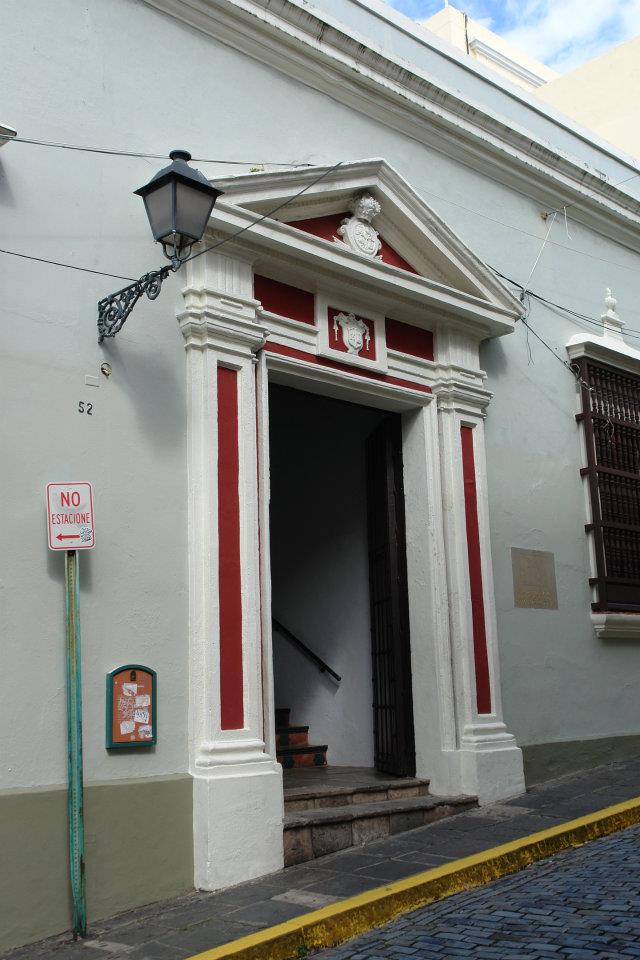English
Conciliar seminar of San Ildefonso (1832)
(Center for Advanced Studies of Puerto Rico and the Caribbean)
Cristo 52 Street
San Juan, Puerto Rico
The original building was completed in the year of 1832 by the special commitment of the first Puerto Rican Bishop, Fray Juan Alejo de Arizmendi, and with financial support from the income obtained from the Municipal Theatre (today Tapia Theatre). In the established seminar, studied not only young people with vocation to priesthood, but also poor and wealthy student, which gave extraordinary prestige to Puerto Rico. There were formed among others: Alejandro Tapia and Rivera, Román Baldorioty de Castro, José Julián Acosta, Federico Asenjo, José. A. Daubón, Calixto Romero, father José María Nazario, Tulio Larrinaga, Rafael's the Valley Atiles, Cayetano Coll and Toste, José Celso Barbosa, Rafael W. Ramírez and many others. Here also began its formation most of our priests and prelates of the 19th century and early 20th century; among them, the cardinal Luis Aponte Martinez and the bishops Monsignor Rafael Grovas, Msgr. Juan Frémiot Torres Oliver and Msgr. Juan de Dios Lopez de Victoria.
This Seminar-School also wrote a glorious page in the initiation and development of scientific studies in Puerto Rico. It was here that in the 1843, the first laboratory of physics and chemistry was installed, donated by father Rufo Manuel Fernández, Galician educator with whom we have a great debt of gratitude.
The school became an important center of public education when the Queen Isabel Segunda approved the incorporation of the departments of physics, chemistry, literature, grammar, rhetoric, arithmetic, geometry, logic, flat, cosmography, metaphysics, kinds of French and English. These chairs were paid for by the Real Sociedad Económica de Amigos del País.
The San Ildefonso Seminar-School constituted, therefore, a cornerstone in the development of public education in Puerto Rico, under the teaching tradition of the Catholic Church. In 1900, Bishop Jaime Blenk closed the seminar. The unoccupied building hosted for a few years the School of San Pablo dedicated to the teaching of children. In 1915, the Bishop Guillermo Jones returned the building to its original destination, by placing it under the direction of the Vincentian fathers. This situation lasted until 1948, in which Bishop Jaime Davis moved the seminary to Aibonito. The old building was for many years home to the school of Saint Thomas of Aquino and convent of Dominican religious.
In 1972, given the ruinous state of the structure the building was closed. In 1984, and with the approval of Bishop Luis Aponte Martínez, Cardinal Arzobispo of San Juan, established the Commission for the restoration of the building of the seminar, chaired by Dr. Ricardo E. Alegría, who led the restoration works. The building project was completed in 1986.
Since then, through agreement with Bishop Luis Aponte Martinez, this historic building houses the headquarters of the Center for advanced studies of Puerto Rico and the Caribbean, where the original educational and cultural mission continues, adapted to the needs of the Puerto Rican today's society, but with the same commitment maintaining the ethical, aesthetic and humanistic values free of racial, political or religious discrimination.
Its location, near the school of fine arts, and headquarters of the Instituto de Cultura Puertorriqueña, helps teachers and students enjoy frequent cultural events (conferences, exhibitions, concerts) that are carried out in the area. Also closely located are, the Museum of the Americas, the Museum of art and history of San Juan the Museum of Puerto Rican Indian, the Museo Pablo Casals and pharmacy, as well as several art galleries. Relatively near the Center are the Municipal Tapia theater, the Museum of fine arts, and the Casa del Libro, continuous artistic centers. Finally, out of the city’s walled enclosure, but within the same isleta de San Juan, the Puerto Rican Ateneo, the Carnegie Library, the library of the legislative chambers, the library of the Supreme Court of Puerto Rico, and finally, the building which is the headquarters of file and the General library of Puerto Rico.
Español
Seminario Conciliar de San Ildefonso (1832)
(Centro de Estudios Avanzados de Puerto Rico y el Caribe)
Calle del Cristo 52
San Juan, Puerto Rico
El edificio original se terminó de construir en el año de 1832 por el empeño especial del primer obispo puertorriqueño, Fray Juan Alejo de Arizmendi, y con la ayuda económica de los ingresos obtenidos del Teatro Municipal (hoy Teatro Tapia). En el colegio-seminario que allí se estableció estudiaron, no únicamente jóvenes con vocación al sacerdocio, sino estudiantes, unos pobres y otros pudientes, que dieron prestigio extraordinario a Puerto Rico. Allí se formaron entre otros: Alejandro Tapia y Rivera, Román Baldorioty de Castro, José Julián Acosta, Federico Asenjo, José A. Daubón, Calixto Romero, el Padre José María Nazario, Tulio Larrinaga, Rafael del Valle Atiles, Cayetano Coll y Toste, José Celso Barbosa, Rafael W. Ramírez y muchos otros. Aquí también comenzaron su formación la mayor parte de nuestros sacerdotes y prelados del siglo xix y principios del siglo xx; entre ellos, el Cardenal Luis Aponte Martínez y los obispos Mons. Rafael Grovas, Mons. Juan Fremiot Torres Oliver y Mons. Juan de Dios López de Victoria.
En este Colegio-Seminario se escribió también una página gloriosa en el inicio y desarrollo de los estudios científicos en Puerto Rico. Aquí fue que se instaló, en el 1843, el primer laboratorio de física y química, donado por el Padre Rufo Manuel Fernández, educador gallego con quien tenemos una gran deuda de gratitud.
El Colegio se convirtió en un importante centro de enseñanza pública cuando la Reina Isabel Segunda aprobó la incorporación de las cátedras de física, química, literatura, gramática, retórica, aritmética, geometría plana, lógica, cosmografía, metafísica, clases de francés y de inglés. Estas cátedras fueron costeadas por la Real Sociedad Económica de Amigos del País.
El colegio-Seminario San Ildefonso constituyó, por lo tanto, una piedra angular en el desarrollo de la educación pública en Puerto Rico, bajo la larga tradición magisterial de la Iglesia Católica. En 1900, el Obispo Jaime Blenk cerró el Seminario. En el desocupado edificio funcionó durante algunos años el Colegio de San Pablo dedicado a la enseñanza de niños. En 1915, el Obispo Mons. Guillermo Jones devolvió el edificio a su primitivo destino, poniéndolo bajo la dirección de los Padres Paúles. Esta situación duró hasta 1948, en el que el Obispo Jaime Davis trasladó el Seminario a Aibonito. El antiguo edificio fué por varios años sede de la escuela de Santo Tomás de Aquino y Convento de Religiosas Dominicas.
En 1972, dado el estado ruinoso que presentaba, el edificio fue clausurado. En el año 1984
, y con la aprobación de S.E.R. Mons. Luis Aponte Martínez, Cardenal Arzobispo de San Juan, se creó la Comisión para la Restauración del Edificio del Seminario, presidida por el Dr. Ricardo E. Alegría, quien dirigió las obras de restauración. Esta labor y la habilitación del edificio se terminaron en 1986.
Desde entonces, mediante acuerdo con S.E.R. Mons. Luis Aponte Martínez, este histórico edificio es la sede del Centro de Estudios Avanzados de Puerto Rico y el Caribe, donde continuamos aquella gestión educativa y cultural, adaptándola a las necesidades de la sociedad puertorriqueña de hoy, pero con el mismo empeño en el desarrollo de los valores éticos, estéticos y humanísticos de nuestro pueblo, libre de discriminación racial, política o religiosa.
Su localización, próxima a la Escuela de Bellas Artes, y a la sede central del Instituto de Cultura Puertorriqueña, facilita a los profesores y estudiantes del Centro el disfrutar de los frecuentes actos culturales (conferencias, exposiciones, conciertos) que se llevan a cabo en la zona, en la que se hallan ubicados, además, el Museo de las Américas, el Museo de Arte e Historia de San Juan, el Museo del Indio Puertorriqueño, el Museo Pablo Casals y de Farmacia, así como varias galerías de arte. Relativamente cerca del Centro quedan el Teatro Municipal Tapia, el Museo de Bellas Artes, y la Casa del Libro, centros de continuas manifestaciones artísticas, y, ya fuera del recinto murado, pero dentro de la misma isleta de San Juan, el Ateneo Puertorriqueño, la Biblioteca Carnegie, la Biblioteca de las Cámaras Legislativas, la Biblioteca del Tribunal Supremo de Puerto Rico, y por último, el edificio que es sede del Archivo y la Biblioteca General de Puerto Rico.










